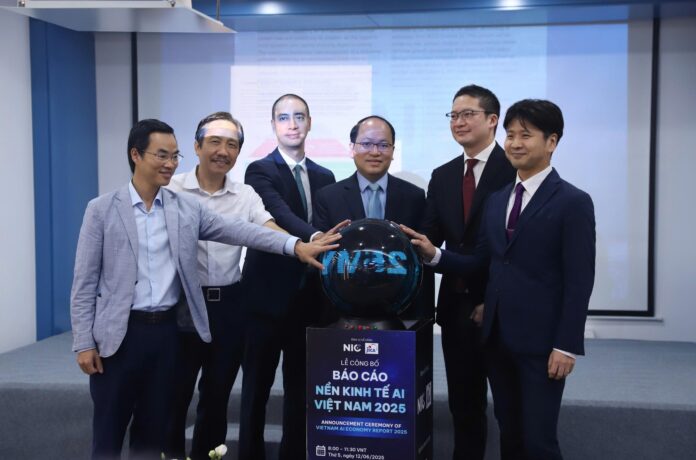Vietnam’s AI economy is projected to reach a scale of $120-130 billion by 2040, according to a report by the National Innovation Center (NIC), Japan International Cooperation Agency (JICA), and Boston Consulting Group Vietnam (BCG). This report, titled “Vietnam’s AI Economy: Seizing the Opportunity and Shaping the Development Orientation,” was released on June 12 in Hanoi and offers a comprehensive overview of the country’s AI landscape.
AI – THE CATALYST FOR VIETNAM’S ECONOMIC SOARING
By 2030, AI is expected to contribute $5 trillion to the global economy, and it will be the main driver of the 4th Industrial Revolution. Governments and leading businesses worldwide prioritize AI in their digital transformation agendas.

Release ceremony of the report “Vietnam AI Economy 2025”, Photo: NIC
In Vietnam, data from 2024 shows that the country ranks 2nd in Southeast Asia for the number of startups and investment capital focused on AI. Vietnam is actively embracing the digital revolution and is recognized as the fastest-growing digital economy in the region, with an impressive annual growth rate of 20%. AI is expected to be the main driver of sustainable economic growth.
BCG forecasts that Vietnam’s AI economy will reach a scale of $120-130 billion by 2040. This growth will be driven by two main factors: First, consumption revenue growth of $45-55 billion due to increased demand for AI-powered products and services. Second, cost savings of $60-75 billion through increased productivity, automation, predictive analytics, and improved efficiency enabled by AI technology.
By 2040, the contribution of AI to the economy by sector is as follows: Manufacturing $25-30 billion, consumer products $15-20 billion, financial services $10-15 billion, telecommunications $10-14 billion, education $10-15 billion, environment and agriculture $7-10 billion, and other sectors $35-40 billion.

Mr. Vu Quoc Huy, Director of NIC, speaks at the announcement ceremony of the report “Vietnam AI Economy 2025” – Photo: NIC
3 PILLARS DRIVING AI DEVELOPMENT IN VIETNAM
The report also identifies three direct drivers of Vietnam’s AI economy: The expansion of AI applications in both the public and private sectors, the development of an AI ecosystem, and the cultivation of a specialized AI workforce that meets international standards.
In addition to these pillars, there are supporting factors for AI development, including enhancing general knowledge and awareness about AI, improving access to high-quality computing infrastructure and data, and establishing clear policies for sustainable AI development.

Overview of the event. Photo: NIC
Enablers of Vietnam’s AI economy include: AI awareness, governance, and safety; AI talent and R&D; AI computing and data infrastructure; AI startup ecosystem; and AI applications in the public and private sectors. A critical enabler is Vietnam’s growing IT and digital workforce, with over 150 universities offering IT-related courses and over 60,000 graduates annually.
AI has already been deeply integrated into various sectors of Vietnam’s economy. In agriculture, for example, AI is used for crop monitoring, pest detection, disease prediction, and timely response suggestions. In healthcare, AI enables personalized healthcare services for vulnerable communities with limited access to medical facilities.
In the field of information and communication, AI systems detect harmful online content and prevent cyber threats to ensure cybersecurity. However, the report also acknowledges that AI implementation in government and public services is still in its early stages, and nationwide expansion faces challenges related to sustainable financial models, inter-sectoral collaboration, and improved access to AI solutions with clear applicability and high cost-effectiveness.
In the private sector, AI has been gradually adopted since 2019, especially in banking, logistics, consumer goods, and healthcare. Banking leads the way in AI integration, and experts anticipate that administrative services, healthcare, and education will increasingly embrace AI, becoming key sectors in Vietnam’s AI economy.
North Binh Province Aims for Over $200 Billion in Trade
The newly merged province of Bac Ninh, born from the unification of Bac Giang and Bac Ninh, has set its sights on an ambitious future. With a vision for prosperity, the province aims to achieve a remarkable total trade turnover of 212 billion USD, alongside a per capita GRDP of 8,500 USD by 2030. This bold endeavor underscores Bac Ninh’s determination to forge a path of economic growth and development, solidifying its standing on the global stage.
“Following the Success of the $8 Billion Deal, the Prime Minister Proposes New Ventures to the 100,000-Strong Corporation.”
This corporation is a shining star in the international aerospace sector. With a stellar reputation for innovation and excellence, it soars above its competitors. Their cutting-edge technologies and pioneering spirit have propelled them to the forefront of the industry, where they continue to push boundaries and reach new heights.
“Seafood Retail Business Booms: Top Performers Rake in Billions”
As of December 2024, the latest statistics from the Ministry of Finance reveal a thriving business landscape in Vietnam. The country boasts an impressive 3.6 million business households and individual business entities, reflecting a vibrant 106% growth compared to the previous year. This significant increase highlights the dynamic nature of Vietnam’s economy and the entrepreneurial spirit of its citizens.





















